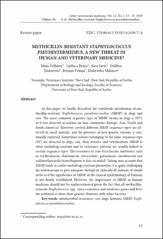Methicillin-resistant Staphylococcus pseudintermedius, a new threat in human and veterinary medicine?

View/
Date
2019Author
Velhner, Maja
Bratić, Ljubica
Savić, Sara
Todorović, Dalibor
Prunić, Bojana
Milanov, Dubravka
Metadata
Show full item recordAbstract
In this paper we briefl y described the worldwide distribution of methicillin-
resistant Staphylococcus pseudintermedius (MRSP) in dogs and
cats. Th e most common sequence type of MRSP strains in dogs is ST71
as it was detected in isolates on four continents (Europe, Asia, North and
South America). However, several diff erent MRSP sequence types are detected
in small animals, and the presence of new genetic variants is continually
reported. Sometimes isolates belonging to the same sequence type
(ST) are detected in dogs, cats, their owners, and veterinarians. MRSP is
oft en multidrug-resistant and its resistance patterns are usually linked to
certain sequence types. Th e resistance to non-beta-lactam antibiotics such
as erythromycin, clindamycin, tetracycline, gentamicin, enrofl oxacin and
sulfamethoxazole/trimethoprim is also recorded. Taking into account that
MRSP tends to confer multidrug-resistant phenotype, it is quite challenging
for veterinarians to give adequate therapy in clinically ill animals. It would
seem as if the signifi cance of MRSP in the clinical epidemiology of humans
is not fi rmly established. However, the importance of MRSP in human
medicine should not be underestimated given the fact that all methicillinresistant
Staphylococcus spp. carry resistance and virulence genes and have
the potential to share their genetic elements with other bacteria.
